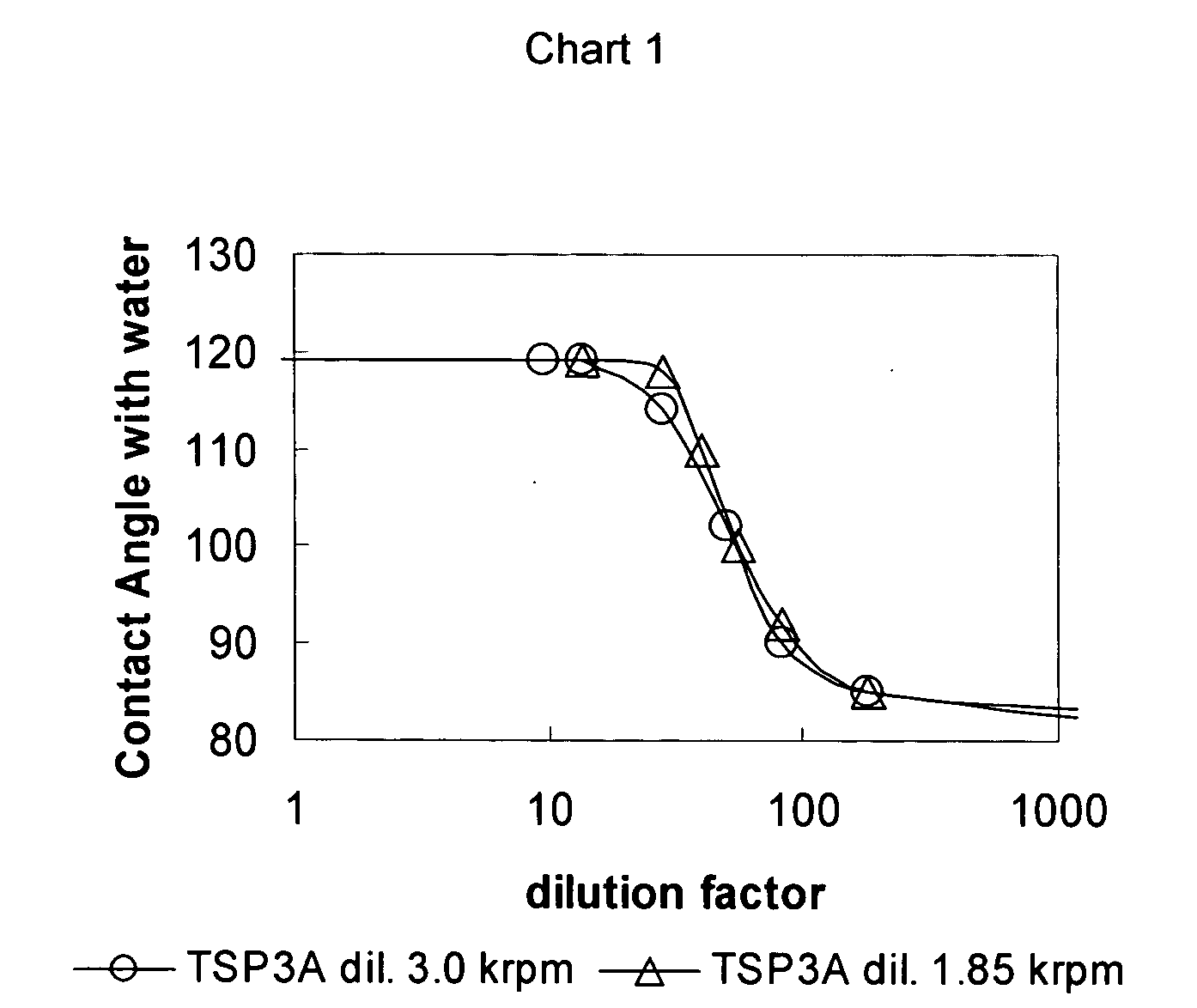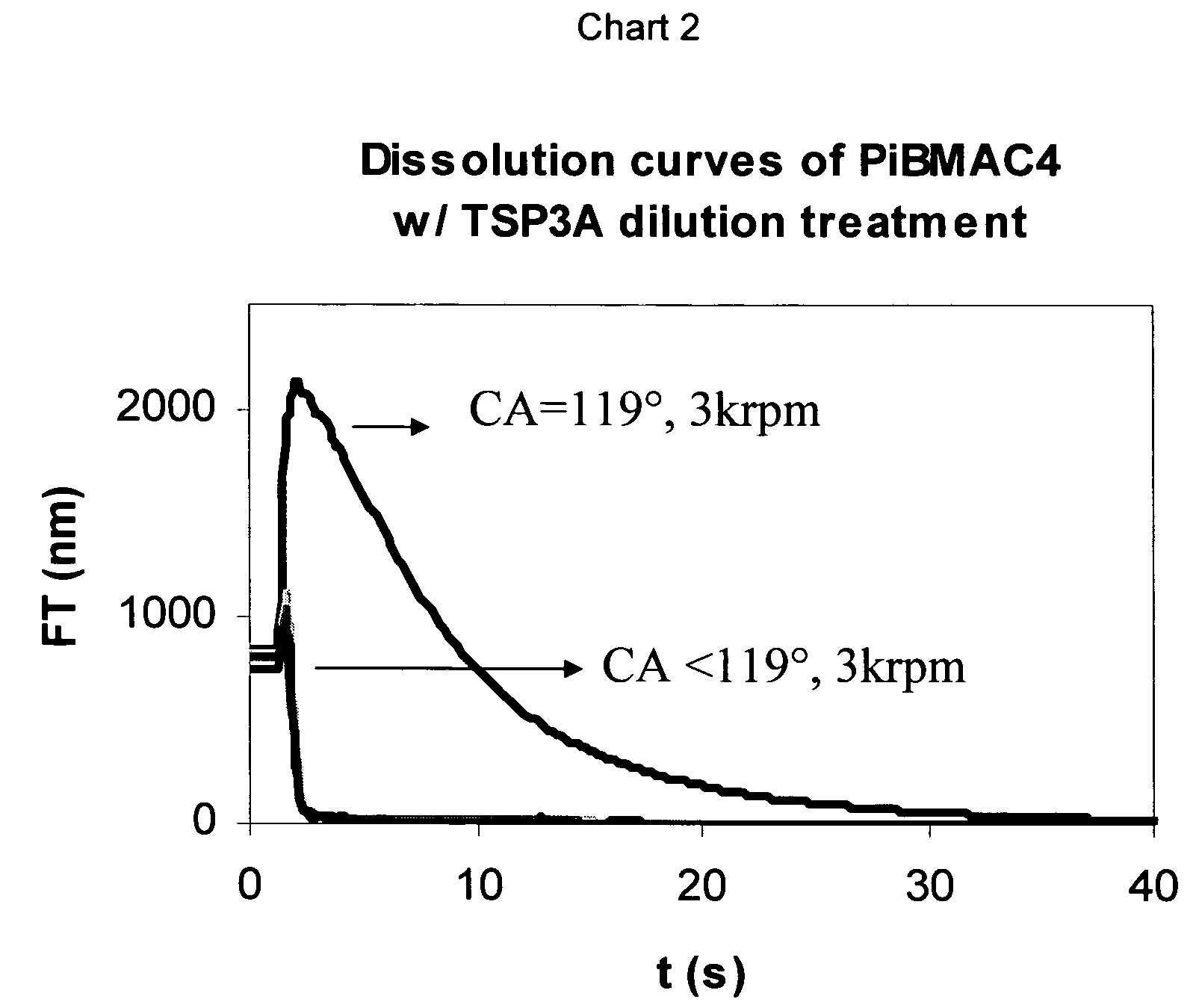Tunable contact angle process for immersionlithography topcoats and photoresists
a technology of immersion lithography and contact angle, which is applied in the field of immersion lithography, can solve the problems of affecting the unmasked photoresist, affecting the effect of the masked photoresist, and requiring significant re-engineering for submerging significant portions of multi-million dollar equipment, etc., and achieves the effect of maintaining a bubble-free even layer of water between the moving lens and the wafer, and achieving the effect of reducing
- Summary
- Abstract
- Description
- Claims
- Application Information
AI Technical Summary
Benefits of technology
Problems solved by technology
Method used
Image
Examples
examples 1-8
[0032]A substrate was coated with a photoresist layer and a standard immersion topcoat material. A fluorinated polymer layer was applied to the top of the standard immersion topcoat material layer via spin coating. The fluorinated polymer was TSP3A, which was diluted by perfluoro-2-butyltetrahydrofuran in various dilution percentages as set forth in Table 1 below. Further, for the examples the spin speed combinations were varied as set forth in Table 1 below. Advancing contact angle values of the fluorinated polymer layer were determined as well as solubility in TMAH and are included in Table 1 below.
TABLE 1Dilution (diluter(g) / Advancingfluorinated polymer orSpin speedcontactSoluble informulation(g))(krpm)angleTMAHExample 11:103119NoExample 21:143119Slow -YesExample 31:281.85118YesExample 41:411.85110YesExample 51:501.85100YesExample 61:831.8592YesExample 7 1:1831.8585YesExample 8 1:10001.8582Yes
[0033]Chart 1 below is a representation of Table 1 above wherein the x-axis is various d...
examples 9-17
[0035]A substrate was coated with a photoresist layer and a standard immersion topcoat material. A fluorinated polymer layer was applied to the top of a standard immersion topcoat material layer via spin coating at 1.85 krpm. The fluorinated polymer was TSP3A which was diluted by perfluoro-2-butyltetrahydrofuran in various dilution percentages as set forth in Table 2 below. Advancing and receding contact angle values of the fluorinated polymer layer were determined and are included in Table 2 below.
TABLE 2AdvancingRecedingDilutionContact Anglecontact angleExample 91:14115115Example 1020115115Example 1124115107Example 122811596Example 133511286Example 144310678Example 155010073Example 16679561Example 17839149Standard - neat7065immersion topcoatsurface (PNBHFA)Standard - neat6545–25immersion topcoatsurface(PMVEMA4Me2Pe)
[0036]Chart 3 below is a representation of advancing and receding contact angles for neat immersion surfaces.
examples 18-31
[0037]A substrate was coated with a photoresist layer and a standard immersion topcoat material. A fluorinated polymer layer was applied to the top of a standard immersion topcoat material layer via spin coating at 1.85 krpm. The fluorinated polymer was CYTOP® (a formulation containing a fluorinated polymer (Poly(1,1,2,4,4,5,5,6,7,7-decafluoro-3-oxa-1,6-heptadiene) in perfluorotributylamine) which was diluted by a perfluorohydrocarbon (Fluorinert™ Fluid FC-77) in various dilution percentages as set forth in Table 3 below. Advancing and receding contact angle values of the fluorinated polymer layer were determined and are included in Table 3 below.
TABLE 3Advancing ContactDilutionAngleExample 181118Example 190.5118Example 200.2117Example 210.15117Example 220.125117Example 230.12117Example 240.115117Example 250.11103Example 260.1100Example 270.1100Example 280.0594Example 290.0190Example 300.00190Example 310.000190
[0038]Chart 4 below is a representation of Table 3 above wherein the x-ax...
PUM
 Login to view more
Login to view more Abstract
Description
Claims
Application Information
 Login to view more
Login to view more - R&D Engineer
- R&D Manager
- IP Professional
- Industry Leading Data Capabilities
- Powerful AI technology
- Patent DNA Extraction
Browse by: Latest US Patents, China's latest patents, Technical Efficacy Thesaurus, Application Domain, Technology Topic.
© 2024 PatSnap. All rights reserved.Legal|Privacy policy|Modern Slavery Act Transparency Statement|Sitemap



